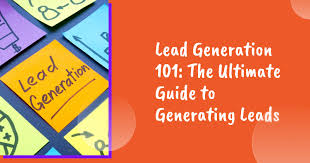Lead Generation 101
In today’s world, where people are bombarded with countless messages and offers daily, marketers need to find effective ways to capture attention and generate genuine interest in their products and services. According to the State of the Connected Customer report, customer preferences and expectations are the top influences on digital strategy for Chief Marketing Officers (CMOs). The ultimate goal of lead generation is to build interest over time that leads to successful sales.
Here’s a comprehensive guide to understanding lead generation, the role of artificial intelligence (AI), and the steps you need to take to effectively find and nurture leads.
What is Lead Generation?
Lead generation is the process of creating interest in a product or service and converting that interest into a sale. By focusing on the most promising prospects, lead generation enhances the efficiency of the sales cycle, leading to better customer acquisition and higher conversion rates.
Leads are typically categorized into three types:
- Qualified Lead: A prospect who has shown a genuine interest and is more likely to convert into a customer.
- Unqualified Lead: A prospect who lacks the necessary interest or engagement to become a customer.
- Warm Lead: A lead that falls between qualified and unqualified; they’ve shown some interest but require further evaluation by the sales team to determine their potential.
The lead generation process starts with creating awareness and interest. This can be achieved by publishing educational blog posts, engaging users on social media, and capturing leads through sign-ups for email newsletters or “gated” content such as webinars, virtual events, live chats, whitepapers, or ebooks. Once you have leads, you can use their contact information to engage them with personalized communication and targeted promotions.
Effective Lead Generation Strategies
To successfully move prospects from interest to buyers, focus on the following strategies:
- Create Content That Addresses Pain Points: Develop strong content that addresses your audience’s pain points and demonstrates how your product or service provides a solution. For example, a project management software company might create videos on project planning tips or case studies to showcase successful implementations.
- Set Up a Lead Scoring System: Implement a lead scoring system to assign points based on specific actions such as webinar attendance or content downloads. Higher scores should be given to leads who consistently engage with high-value content, enabling your sales team to prioritize those more likely to convert.
- Identify and Use the Right Channels: Understand which social media platforms your target audience uses. For instance, visually-oriented businesses might find better engagement on platforms like Instagram or Pinterest. Tailor your content and presence to match the preferences of your audience.
- Craft Compelling Calls-to-Action: Ensure that your calls-to-action (CTAs) are clear and persuasive, and that your design is user-friendly. A well-crafted CTA on a landing page, combined with customer testimonials, can significantly improve conversion rates.
- Perform A/B Testing: Use A/B testing to compare different versions of headlines, visuals, or CTAs. Analyze real-time performance data to refine your approach. For instance, test different email subject lines to determine which ones yield higher open rates.
How Lead Qualification and Nurturing Work
To effectively evaluate and nurture leads, consider the following:
- Define Your Ideal Customer Profile (ICP): Assess potential leads based on their interest level, budget, and buying authority. This helps in identifying which leads are worth pursuing.
- Use the BANT Framework: The BANT (Budget, Authority, Need, Timing) framework helps in assessing lead readiness by evaluating:
- Budget: Does the lead have the financial resources to invest in your product?
- Authority: Is the lead a decision-maker?
- Need: Does the lead’s need align with what your product offers?
- Timing: Is the lead ready to make a purchase in the near term?
- Implement Lead Scoring and Grading: Assign numerical values to leads based on their behavior and interactions (scoring) and evaluate their fit within your target market (grading). For example, a lead downloading a product demo should receive a higher score than one who only visited the homepage.
Methods for Nurturing Leads
Once you’ve established your lead scoring and grading, consider these nurturing methods:
- Email Drip Campaigns: Automated email sequences, such as welcome notes or targeted follow-ups, help nurture leads over time by delivering relevant messages and building trust.
- Webinars and Virtual Events: Host events to interact with leads directly and gain customer insights. For example, a software company might conduct a webinar series on advanced features.
- Personalized Content: Tailor content to individual preferences, such as recommending products based on browsing history.
- Social Media Engagement: Participate actively on relevant social media platforms to engage in industry discussions and share content.
- Interactive Content: Use quizzes or assessments to engage leads and gather data on their preferences, which can inform future content and promotions.
Current Trends in Lead Generation
AI is increasingly influencing lead generation by offering advanced tools and strategies:
- AI Tools: Utilize AI-driven tools to analyze customer behaviors and preferences, predict engagement, and recommend content. AI can also enhance targeting and personalization efforts.
- Automation and Personalization: Leverage marketing automation to deliver personalized content at scale. Automated campaigns can adapt content based on lead behaviors, improving client satisfaction and increasing the likelihood of repeat business.
- Video Marketing: Engage leads with compelling video content such as product demos, testimonials, or educational pieces. Videos are highly engaging and can be promoted across social media and email campaigns.
Measuring Success in Lead Generation
To evaluate the effectiveness of your lead generation efforts, track the following key metrics:
- Conversion Rate: The percentage of leads that complete a desired action, such as filling out a form or making a purchase.
- Cost Per Lead (CPL): The cost of acquiring a single lead, calculated by dividing total spend by the number of leads generated.
- Lead Quality: Assess the likelihood of leads converting into customers, based on lead scoring and grading.
- Return on Investment (ROI): Measure the overall effectiveness by comparing revenue generated to the total investment in lead generation.
Best Practices for Lead Generation
To optimize lead generation efforts and build strong customer relationships, follow these best practices:
- Target the Right Audience: Use data analytics to understand buyer personas and focus on segments that align with your product or service.
- Define and Review Lead Qualification Criteria: Regularly adjust your lead scoring system based on data and feedback.
- Maintain Consistent Brand Messaging: Build trust by delivering on promises and showcasing customer testimonials.
- Use CRM Tools: Track lead interactions and communication history for a comprehensive view of each lead’s journey.
- Optimize Lead Capture Forms: Keep forms concise and strategically placed on landing pages.
- Leverage AI and Machine Learning: Use AI to analyze data, predict lead behavior, and automate personalized interactions.
- Iterate and Improve: Regularly assess your strategies, gather feedback, and adapt to ensure continuous improvement.
Effective lead generation is essential for building trust and fostering meaningful customer relationships. By implementing these strategies and best practices, you can enhance your lead generation efforts and drive better business results.










